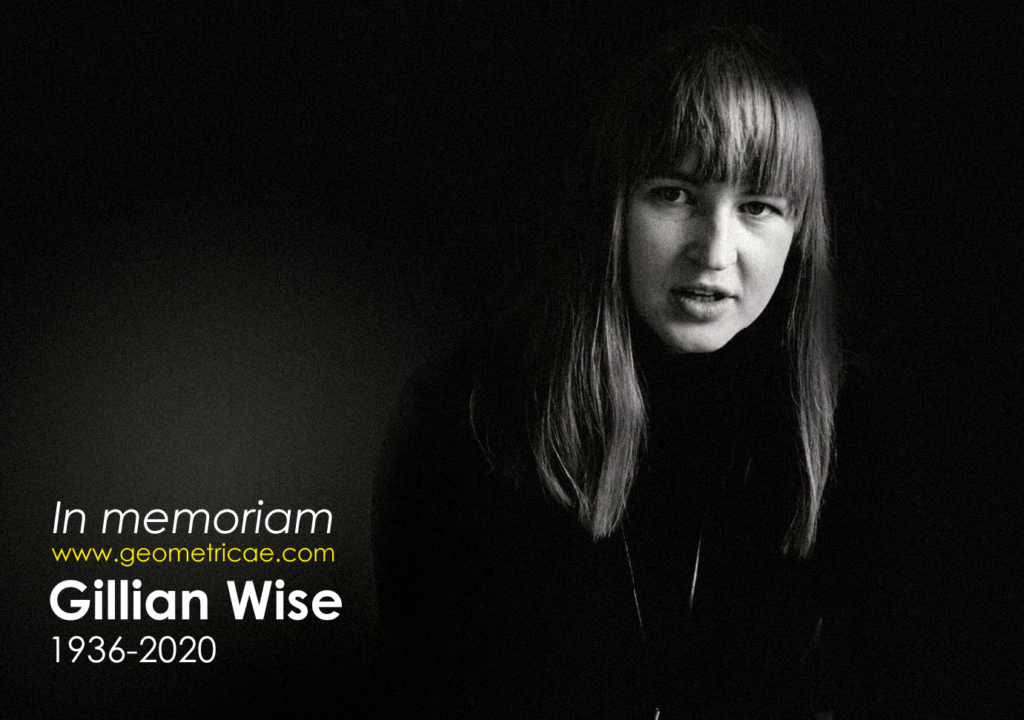Gillian Wise | Ilford | England | 1936-2020
Born in 1936 in Ilford, Wise studied at Wimbledon School of Art (1954-57), where she became a close friend of fellow student Richard Hollis, with whom she shared an interest in Concrete Art, Laurence Alloway’s Nine Abstract Artists (1954) and Charles Biederman’s Art as the Evolution of Visual Knowledge (1948). Later that decade she travelled with Hollis Ulm and Zürich to visit several artists’ studios. On another trip, to Paris, she met the Belgian artist and founder member of the De Stijl group Georges Vantongerloo: from him, she kept a letter saying how moved he had been by her work. She saw herself as a torchbearer for a specifically European modernism in a day when modernism and Europe were out of fashion.
In London she had become acquainted with Anthony Hill and soon became associated with the British Constructionist group – with Victor Pasmore, Kenneth and Mary Martin, John Ernest and the circle around Hill’s Charlotte Street apartment – becoming one of its youngest members in 1961. That same year, alongside Hill and others, she showed an ambitious wall relief at the Sixth Congress of the International Union of Architects at the South Bank. She became a close companion of Hill, contributing a text on ‘the art work as an object’ to his anthology DATA: Directions in Art, Theory and Aesthetics (1968) and with him, in the mid-1970s, founding the short-lived ARS (Arts Research Syndicat). Her interest in the longer histories of constructivism and the cultural politics of the modern movement more generally took her on a UNESCO Fellowship to Prague in 1968 and on a British Council Scholarship to research the Soviet Modern Movement in Leningrad in 1969 and 1970. It was there that she met the Romanian architect Adrian Ciobotaru whom she married (and divorced in 1980), and with whom she had a son, Alexander, in 1975.
In 1970 she became a member of the Systems Group, joining Jeffrey Steele, Peter Lowe and others, and taught at Chelsea School of Art between 1973 and 1982. Fascinated by the geometries of visual phenomena, she worked for the most part with relief, making orthogonal compositions in acrylic, aluminium and wood, often exploring interpenetrating lines and planes, transparencies, reflections, refractions and the ways in which light could be harnessed as an integral part of the surfaces and structures of her works. Varied colour too became an increasingly important characteristic of her work, as she explored different kinds of paints, their applications and effects. Her reputation for thought-provoking and visually compelling reliefs earned her several commissions in the following decades, including Nottingham University Hospital (1973), the Hayward Annual (1978) (a co-selector with Tess Jaray, Liliane Lijn, Kim Lim and Rita Donagh), the Open University (1980), Unilever House (1982) and the Barbican Arts Centre (1982). Her ‘Alice Walls’, a mural composed of mirror, metal and spray paint, still exists across three storeys on the stairs to the Barbican’s main cinema.
After a period working at universities in the United States in the early 1980s, Wise relocated to Paris in 1987 and although continuing to make work there (especially paintings) well into her later years, she also turned increasingly to text, not only as a prolific letter writer, writing daily to friends and artists back in Britain, but also publishing two books about her life and work: Low Frequency (2003) and Gillian Wise: Twenty Small Works and the Alice Walls at the Barbican (2011), both designed by her son, who also created her website. Long overdue, these fascinating books coincided with renewed interest in her work in the early 2000s, coinciding with art historical reconsiderations of British Constructionism (notably Alistair Grieve’s A Neglected Avant-Garde of 2005) and with younger generations of artists encountering her work afresh, inspired by her contribution to constructivist art.
In 2010, Wise’s work was included in the Tate Britain show Construction England; in 2017, in British Constructivism at Pallant House gallery, Chichester. The Drawing Room gallery’s 2019 Drawing Biennial featured a work by the artist Andrew Bick called Drawing for Gillian Wise #1. And, in 2004, The Alice Walls, threatened with destruction, was saved after public outcry. Ten years later, a small plaque was finally affixed to the work, naming Wise as its maker. Her Red series of paintings, begun in 2002 and unfinished at her death, suggest an extraordinary maturing of eye and mind.
